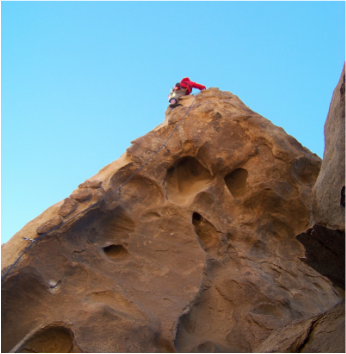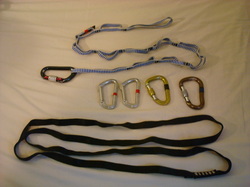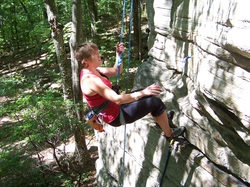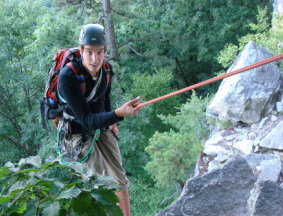Setting a Bolted Anchor
 Rob setting a sport anchor atop Necessary Evil 5.10b, Apple Valley Crags, CA
At the top of most sport routes you will find two fixed bolts meant to provide an anchor. From this anchor, you will either be lowered through your partner's belay device or rappel off. Your partner will then climb the route on top rope and clean the quick draws that you placed, relying on the same anchor. For all of these scenarios, your anchor must be high quality. The bottom line is: if your anchor fails YOU OR YOUR PARTNER DIES.
Sport climbing outside is not just "get to the top and clip into whatever you find." You're not in a gym, so no one is going around every night inspecting the safety or quality of every bolt. Bolts degrade over time and some bolts are drilled in precarious positions to begin with. Bottom line: inspect everything for yourself. If you get to the top of a climb and the bolts are rusty, spinning, or loose, you should have the knowledge to improvise a better situation for yourself. You must be competent in the basic premises of anchor-setting before putting your life on the line. Read Basic Principles of Anchors. This article assumes that you already have "SARENE-SA" anchors as a knowledge base. |
|
Step By Step: Setting the Anchor

The gear you need to build a basic anchor.
At minimum, you will need:
To set the Anchor:
- 4 carabiners: at least 2 locking
- One 48" runner
- Personal anchor system: a runner with a locking carabiner that is girth hitched to your harness (on the secure loops that you use to attach to the rope)
To set the Anchor:
- Do a quick inspection of the bolts. They should be free of rust, generally unworn, and SHOULD NOT SPIN. We have found a number of spinners out there, and they can be really dangerous; some compression type bolts need to be under tension from the bolt to hold in the rock.
- Identify a secure bolt and clip into it with your personal anchor system. Be sure to lock your carabiner! You can now tell your partner that you can be taken off belay. Be sure to use good communication with your partner. EX: climber: "Cristina, OFF BELAY!" belayer: "Rob, OFF BELAY!" *If you are really pumped, it may be quicker to put in a quickdraw and have your partner take on the rope after you clip in - this might give you the rest you need before setting the anchor.
- Clip one locking carabiner onto each bolt.
- Clip the runner into both lockers so it makes a loop through the lockers.
- Form either a Sliding X or a Figure 8 on a Bight in the the runner. The Sliding X will provide dynamic equalization but will also extend in the event of one of your bolts failing, thus violating the NE in SARENE-SA. The Figure 8 will not equalize dynamically, but will also not extened in the event of a failed bolt. Read more about the pros and cons of each here to make an informed decision on which to use.
- Clip a locking carabiner or two opposite and opposed biners into your Sliding X or Figure 8 on a Bight.
- Lock all of your locking carabiners.
- Double check everything (SARENE-SA): are the bolts secure? Are all your lockers locked off? Is your anchor equalized and redundant? Is there minimal extension? Are all your angles small?
Step by Step: Getting Down

Caitlin getting lowered off a route at Rose Ledges, MA.
You
can either get lowered off the anchor (faster) or you can rappel (more
fun). The set up is different for each, so read both variations.
Variation #1: Get lowered off the anchor
If you want to climb the route top-rope, or your partner wants to lead the route, this is your fastest option.
Variation #1: Get lowered off the anchor
If you want to climb the route top-rope, or your partner wants to lead the route, this is your fastest option.
- Clip the rope into the bottom locker (or opposite and opposed carabiners) and lock off the biner. Make sure the rope enters from behind and exits away from the rock and to your harness.
- Call for your belayer to take tension. Use good communication. EX: climber: "Cristina, ON BELAY!" belayer: "Rob, ON BELAY!"
- Double check everything one more time (SARENE-SA? are all lockers locked? opposite and opposed?). If you're feeling a littler nervous, you can relieve tension from your personal anchor (while still leaving it attached) so that all your weight is on the anchor and the belay but you have the back up of the personal anchor. How does it feel? solid?
- Unclip your personal anchor
system. Your weight is now fully on the anchor and the belay system.
- Communicate to your partner that you are ready to lower off the route. EX: "READY" or "LOWER"
- You can unclip bolts as you go down to make the climb easier for your partner. Be sure to leave in bolts that will prevent the next climber from having a large swing potential on the way up on top rope.
Variation #2: Rappelling

Rob rappelling off the top of the Gunks, NY
- This takes a little longer, but it is more fun, and you won't put as much wear on your top carabiners.
- Your belayer should already be off belay and have the rope removed from their belay device. Make sure this is the case.
- Pull up some slack in the rope (approximately 2') and secure the rope to your harness using a clove hitch to a carabiner, a figure 8 on a bight to a carabiner, or a simple overhand through your gear loops. This knot ensures that you do not drop the whole rope down to the ground and does not need to hold any weight except its own.
- Untie the figure 8 and safety knot that attaches the end of the rope to your harness.
- Pass this end of the rope through the bottom locking carabiner in your anchor (or opposite and opposed biners).
- Tie a Stopper Knot in the tail end of the rope to ensure that you don't rap off the end. Also have your partner tie a stopper knot on the end that is on the ground close to them (this is a good habit to form even if you're not currently worried about it).
- Pull half the length of the rope up from the ground and through your anchor's bottom carabiner. If it is a straight shot to the ground, you can let the rope run down to the floor. If there are ledges or cracks that could snag your rope, consider flaking the rope over your personal anchor while you pull it up. When the half-way point of the rope is resting in the anchor, you can gather your flaked rope and safely throw it off the cliff, avoiding these hazards. Remember to yell, "ROPE!"
- Make sure both ends are on the ground. You don't want to get stuck in mid air!
- Attach your belay device to both sides of the rope and to your harness. See our article on rappelling for instructions.
- Double check everything one more time (SARENE-SA? are all lockers locked? opposite and opposed?). If you're feeling a littler nervous, you can relieve tension from your personal anchor (while still leaving it attached) so that all your weight is on the anchor and the belay device but you have the back up of the personal anchor. How does it feel? solid?
- Communicate to your partner that you are ready to rappel. Have them give you a fireman's belay if possible.
- Rappel!
- Have fun!
Retrieving Your Anchor Gear
Now all your gear is at the top of the rock face and you're ready to move along....what now?
Walk Off: The easiest option is to walk to the top of the route (if you can), secure yourself at the top of the cliff, and lean over and clean out the anchor. Then you can simply walk off the cliff, at most popular climbing destinations there will be developed trails. Of course, the second climber can also simply walk off the top of the route immediately after the climb as well. Take care to always have a secure point of connection between your body and something solid while cleaning the anchor. You can clip yourself into one of the top bolts or secure yourself via a girth hitch to a tree with a runner and your personal anchor.
Rappel Off: Unfortunately, you can't just walk off every route. If this is the case, you will need to rappel off fixed anchors with chains. You never want to lower off fixed bolts because the friction will greatly compromise your rope. You also never want to rappel off bolts for the same reason. Routes with no walk offs will hopefully have chains or something suitable to rappel off of. Simply secure yourself to the fixed anchor with your personal anchor system, clean your pieces, and set up a rappel off the chains.
Walk Off: The easiest option is to walk to the top of the route (if you can), secure yourself at the top of the cliff, and lean over and clean out the anchor. Then you can simply walk off the cliff, at most popular climbing destinations there will be developed trails. Of course, the second climber can also simply walk off the top of the route immediately after the climb as well. Take care to always have a secure point of connection between your body and something solid while cleaning the anchor. You can clip yourself into one of the top bolts or secure yourself via a girth hitch to a tree with a runner and your personal anchor.
Rappel Off: Unfortunately, you can't just walk off every route. If this is the case, you will need to rappel off fixed anchors with chains. You never want to lower off fixed bolts because the friction will greatly compromise your rope. You also never want to rappel off bolts for the same reason. Routes with no walk offs will hopefully have chains or something suitable to rappel off of. Simply secure yourself to the fixed anchor with your personal anchor system, clean your pieces, and set up a rappel off the chains.
